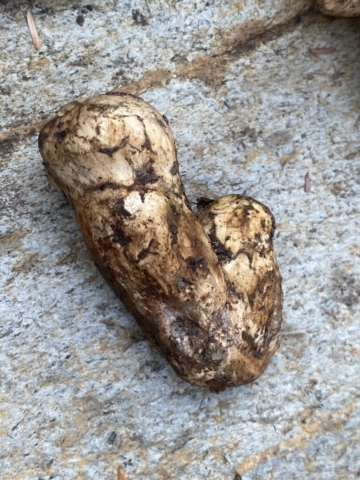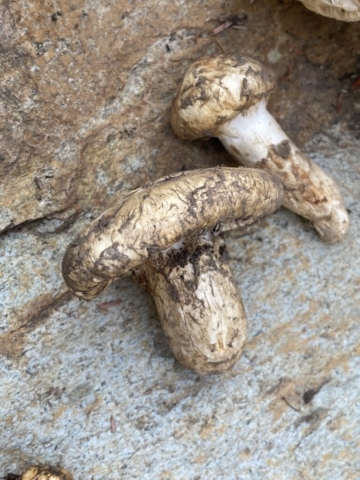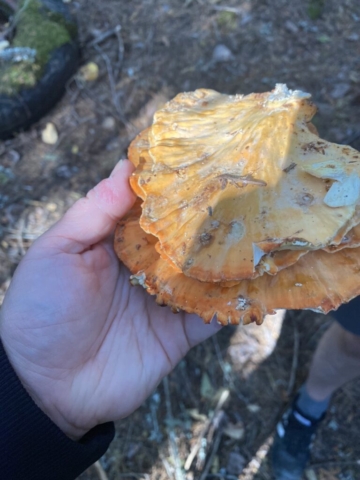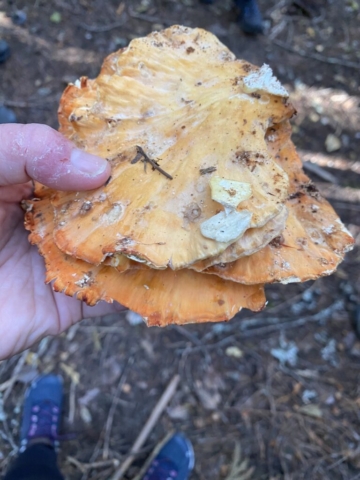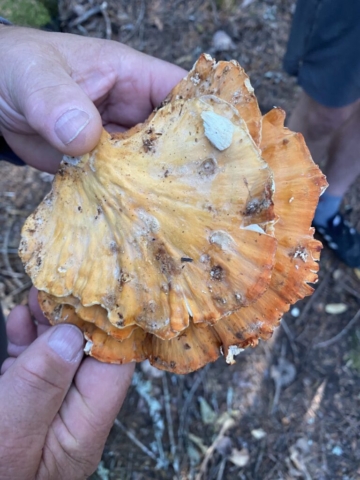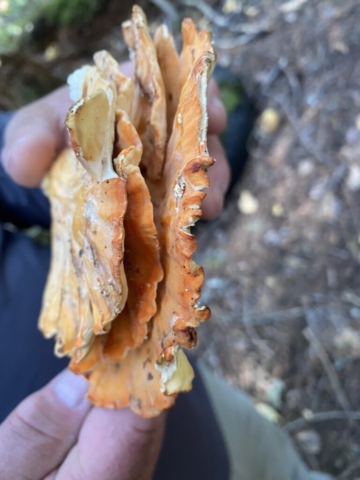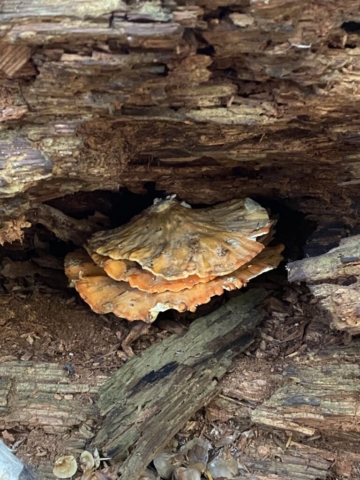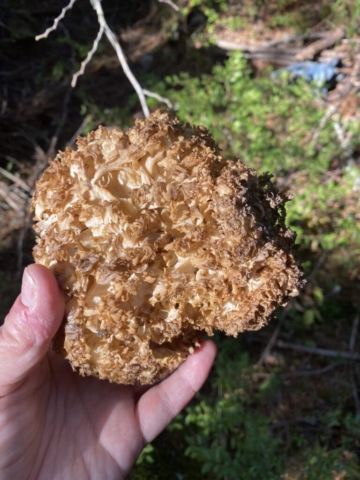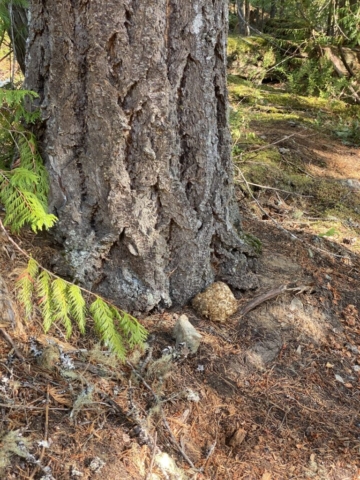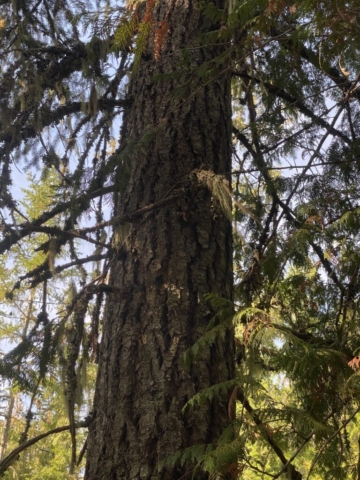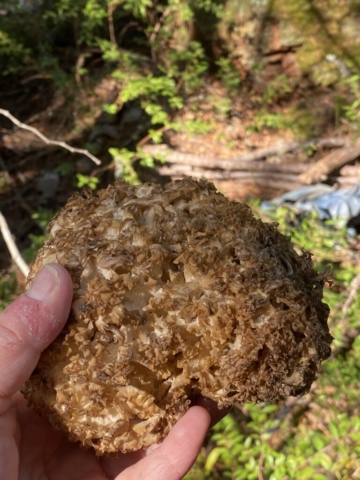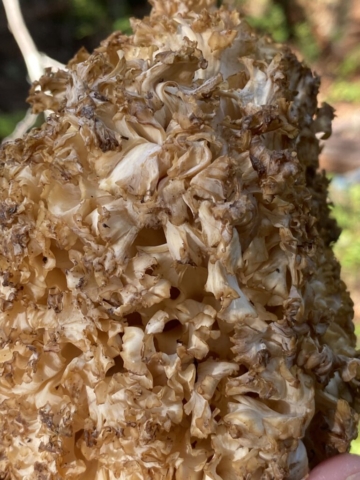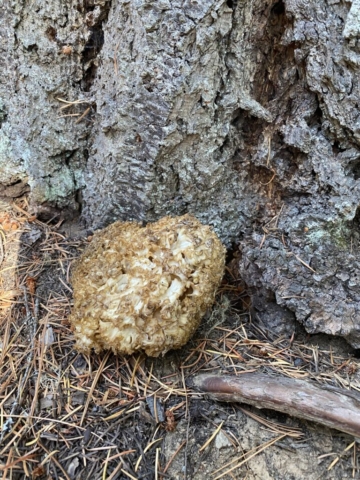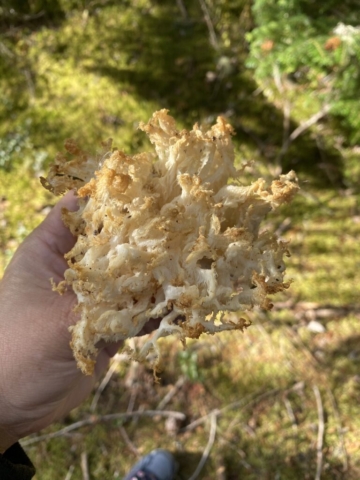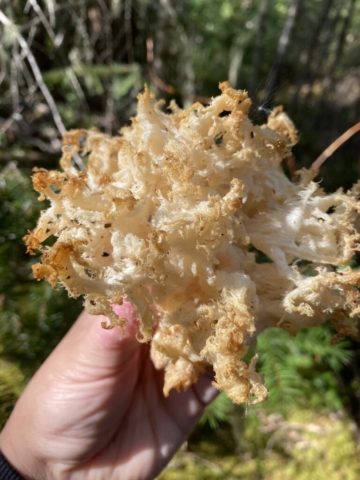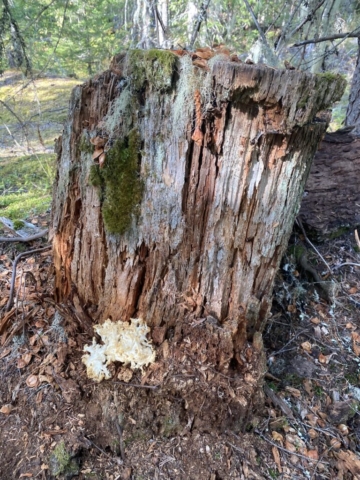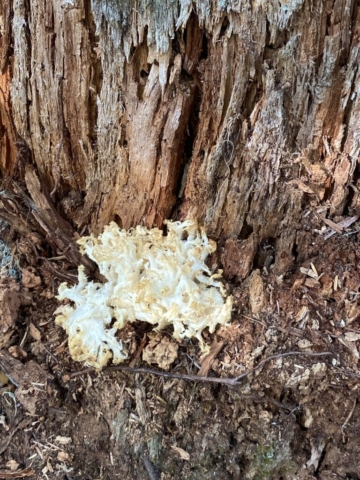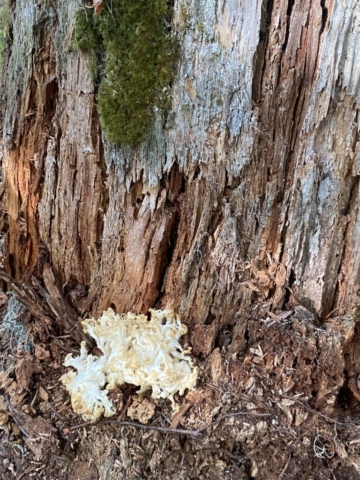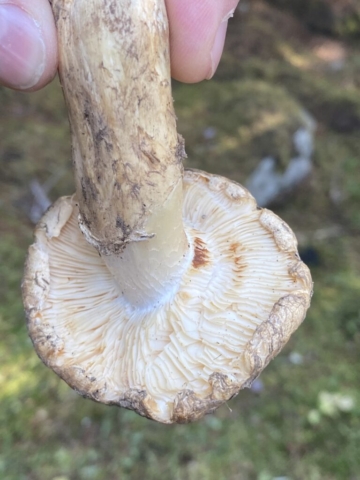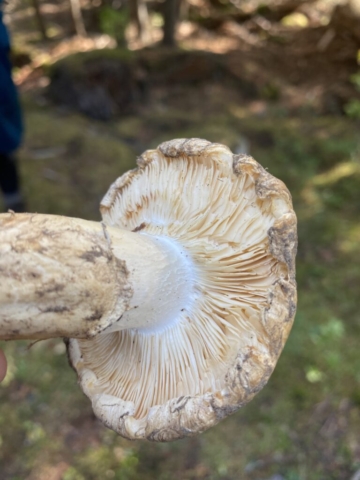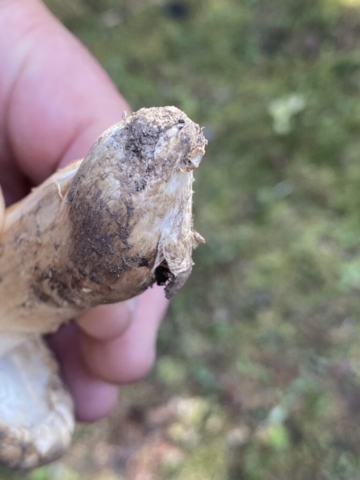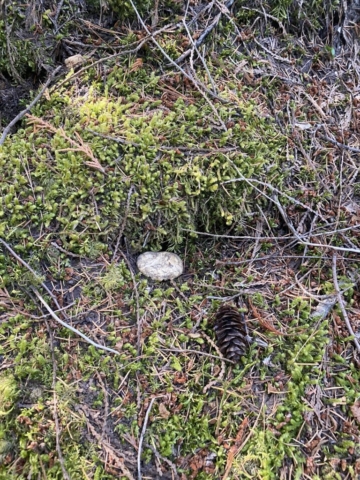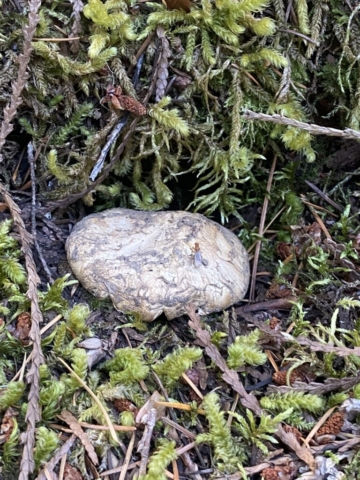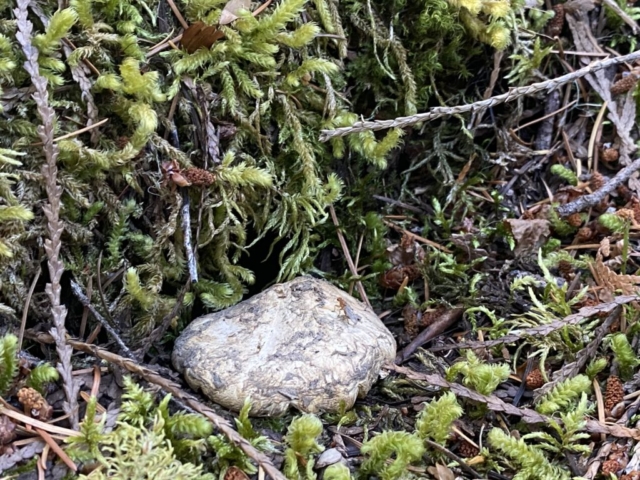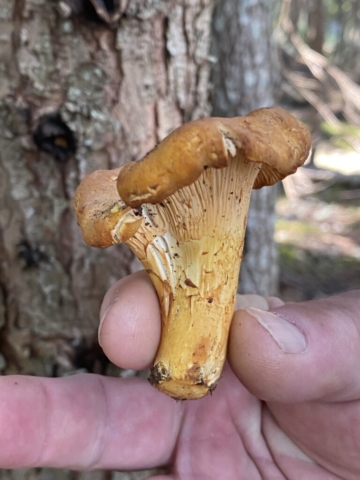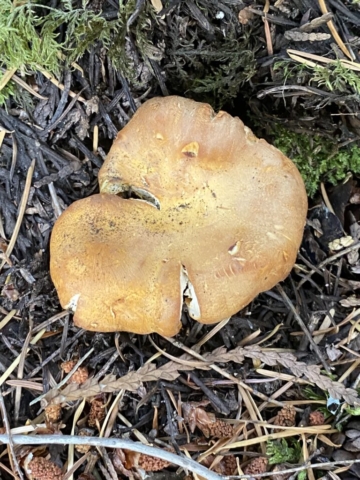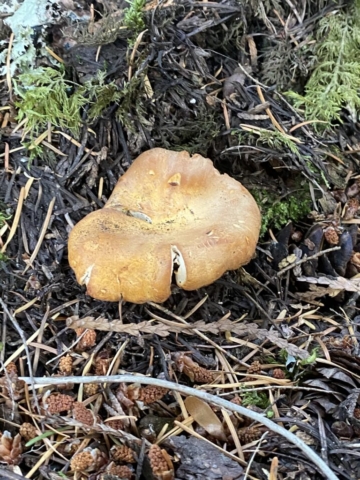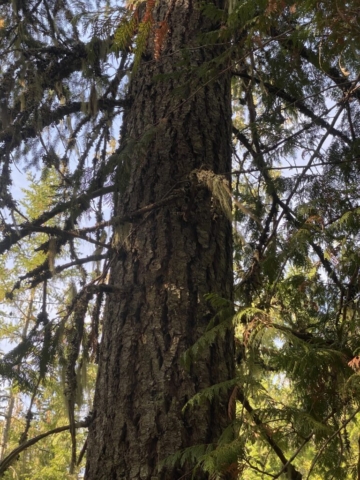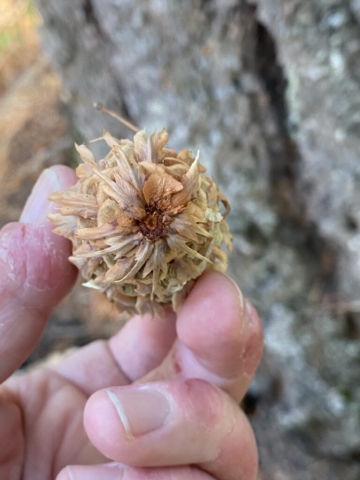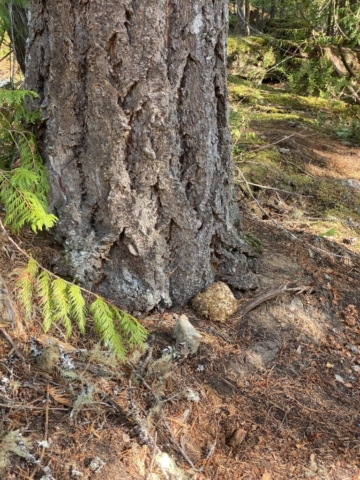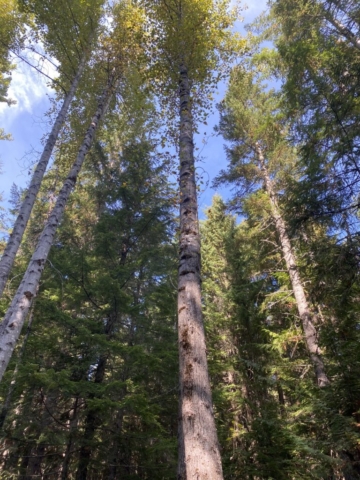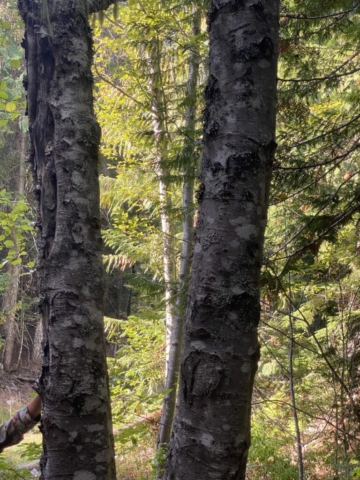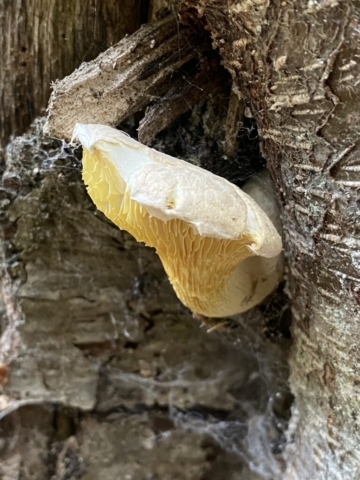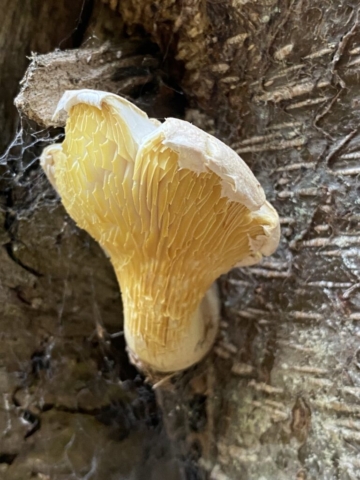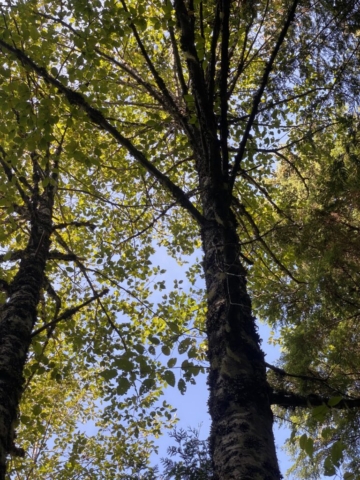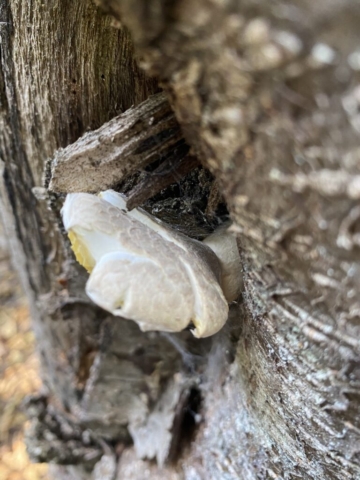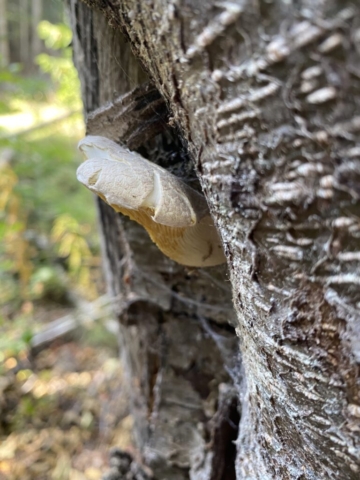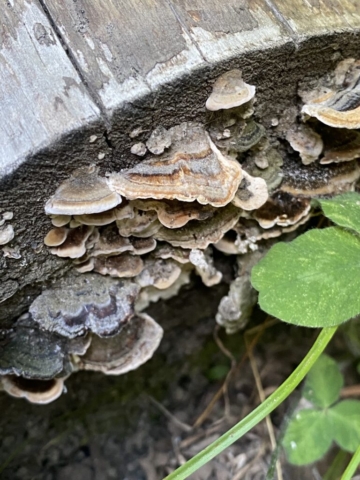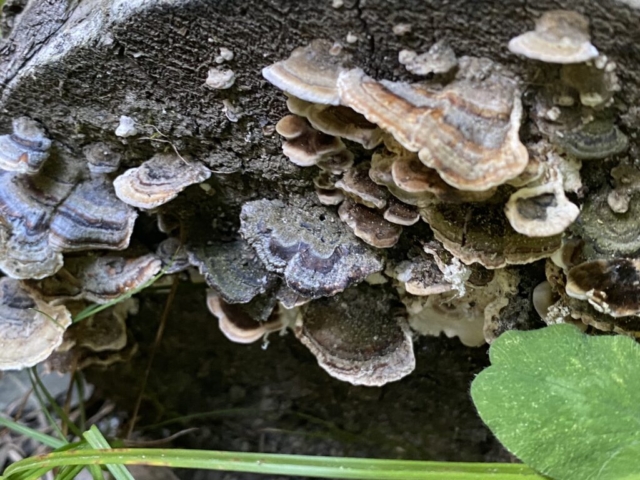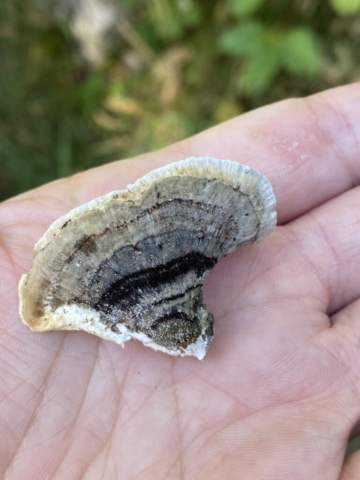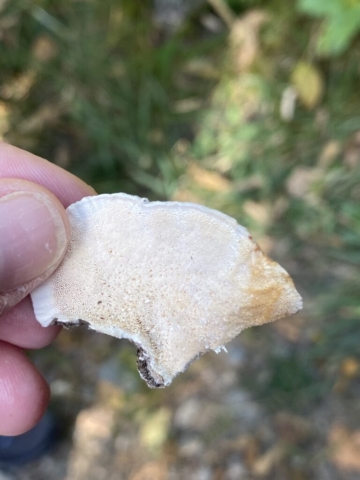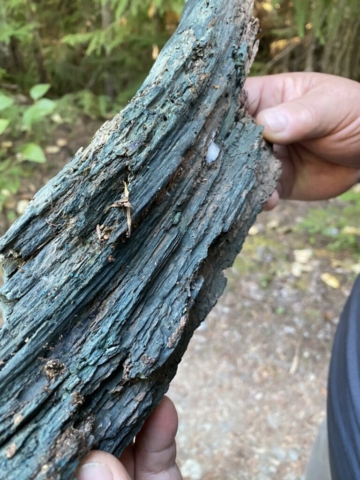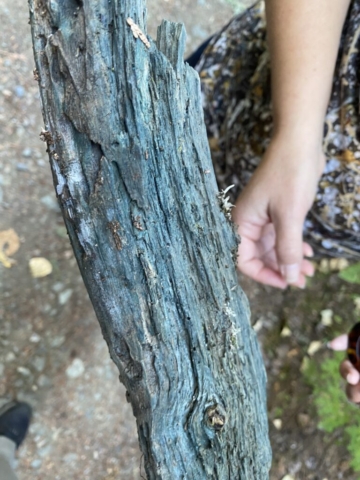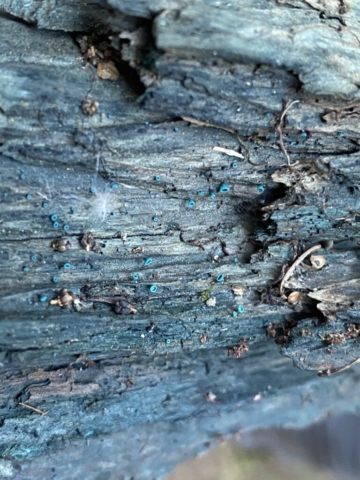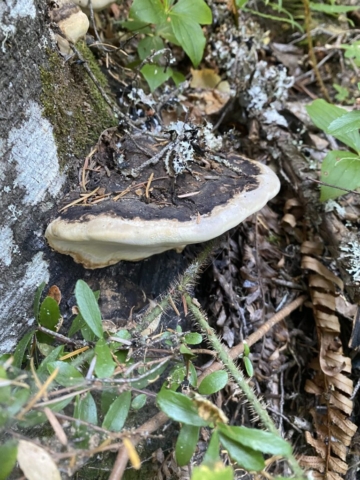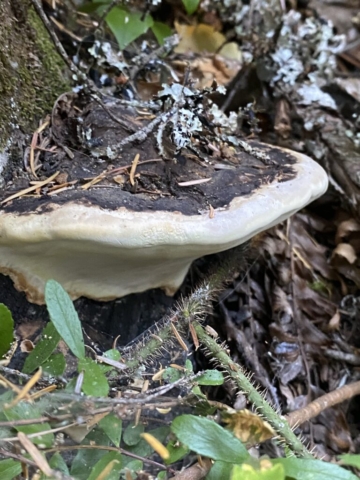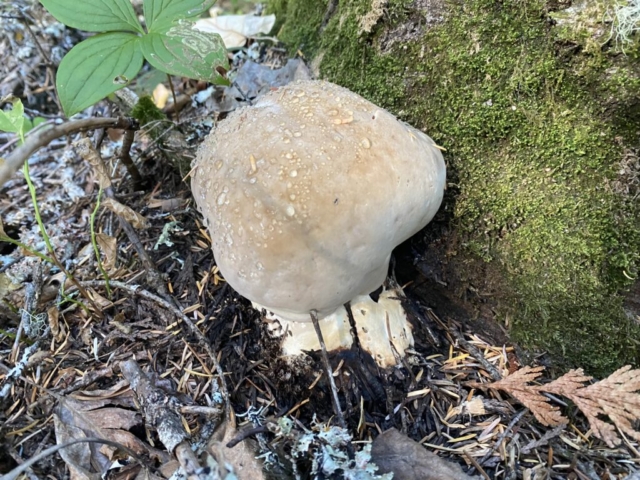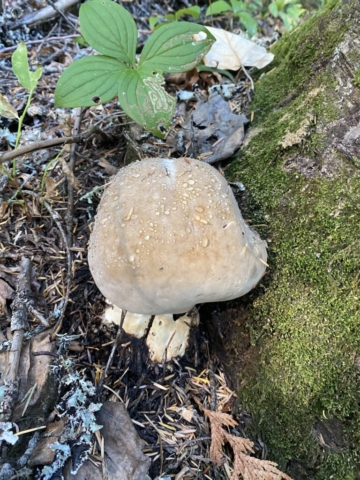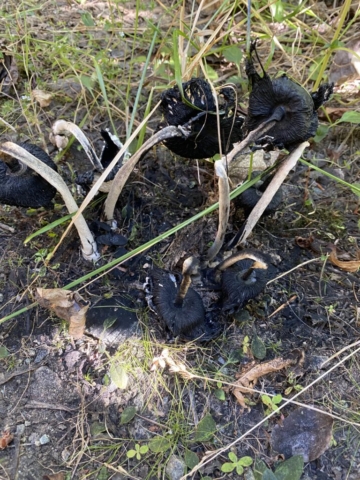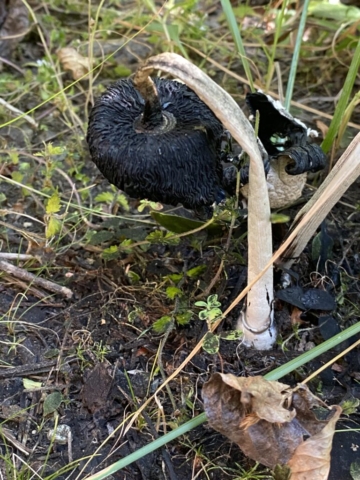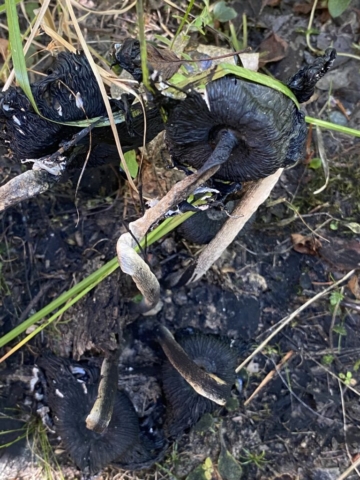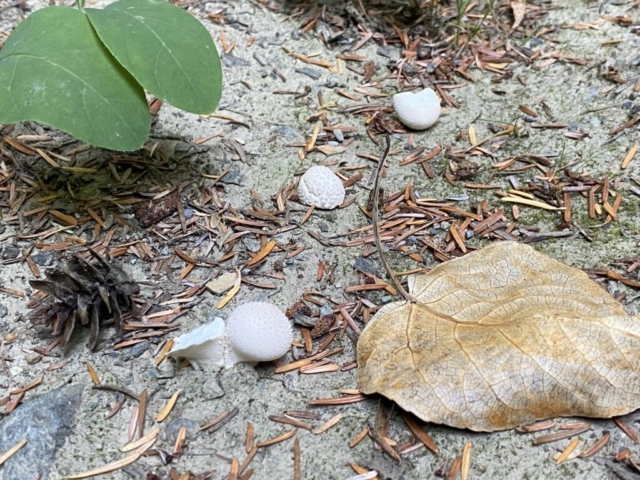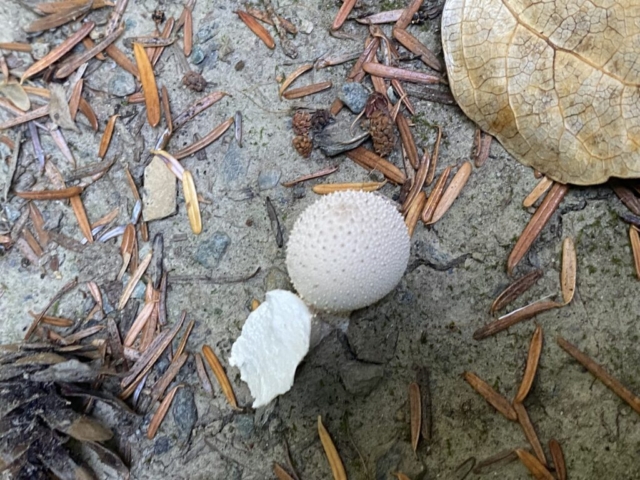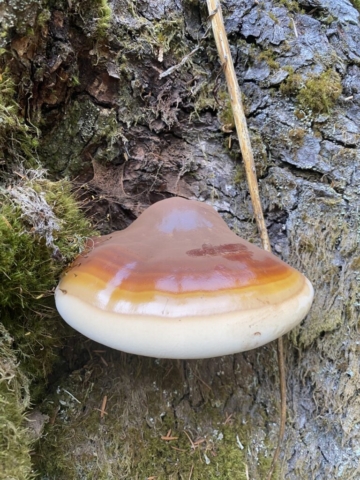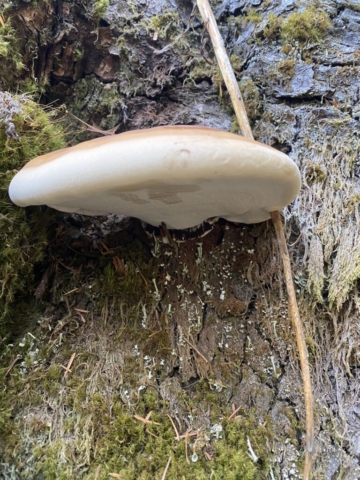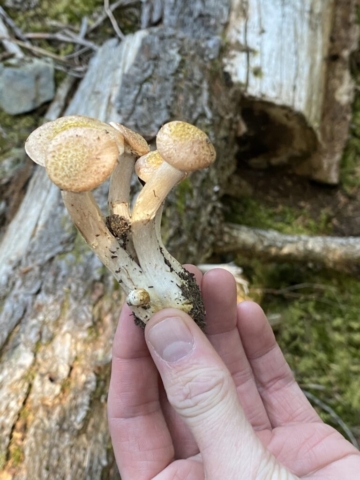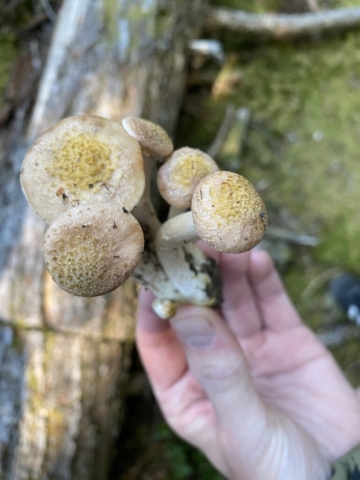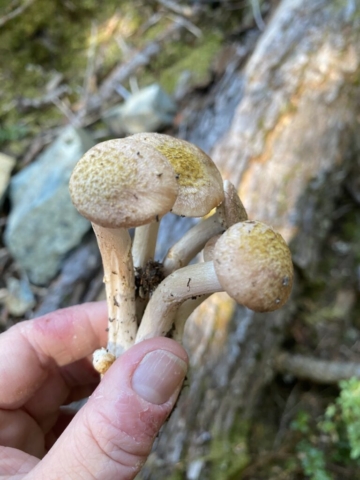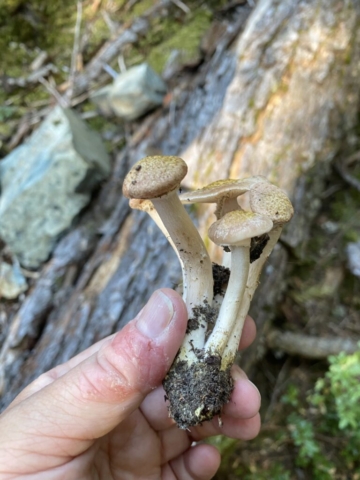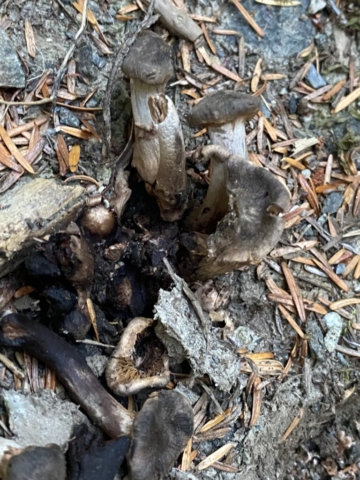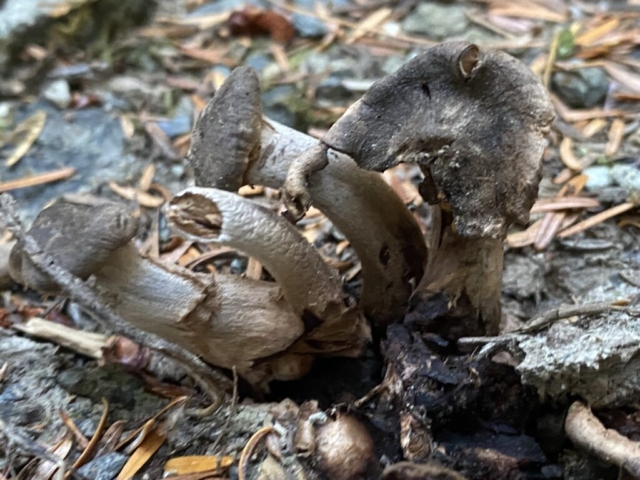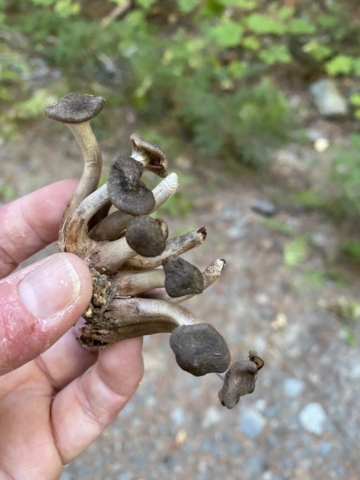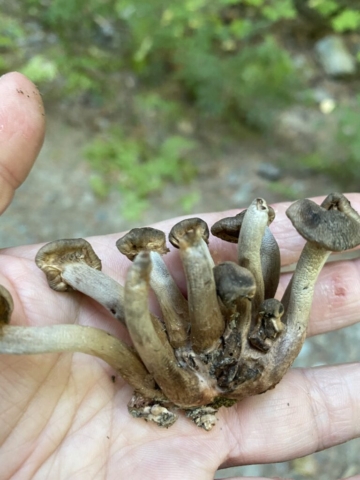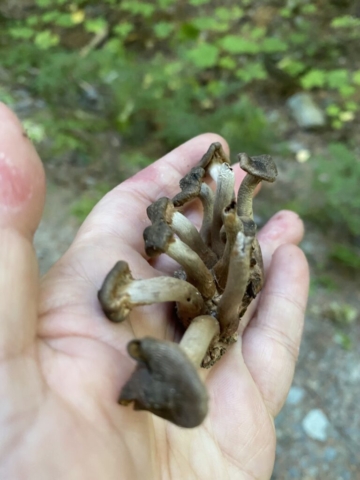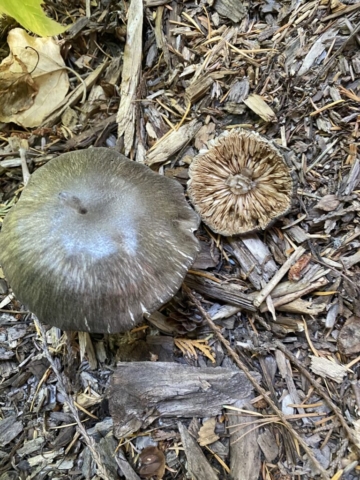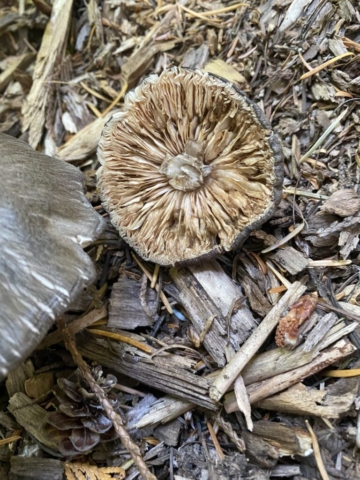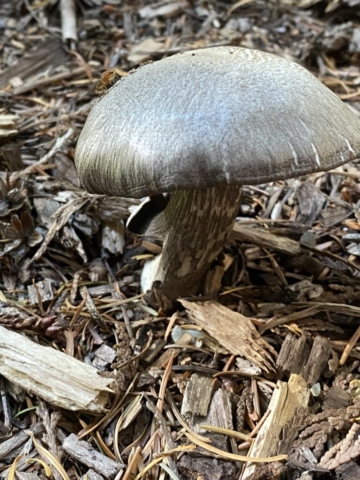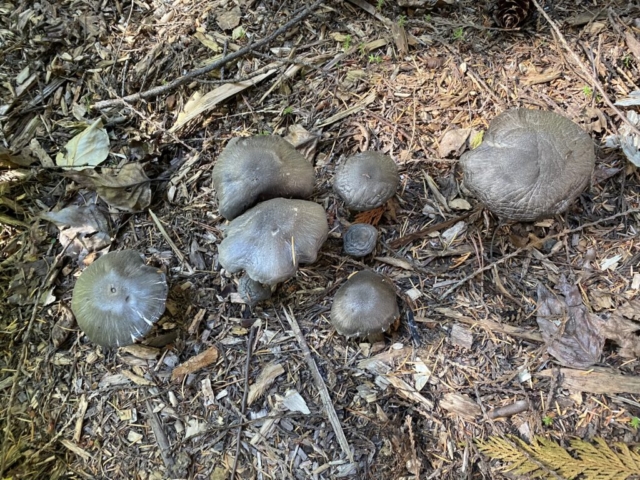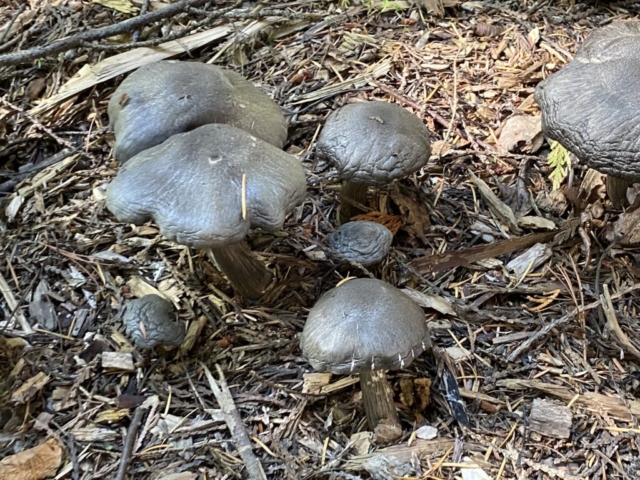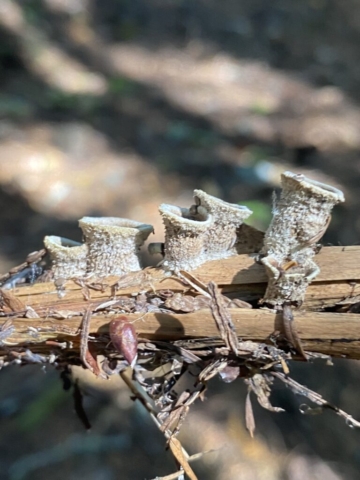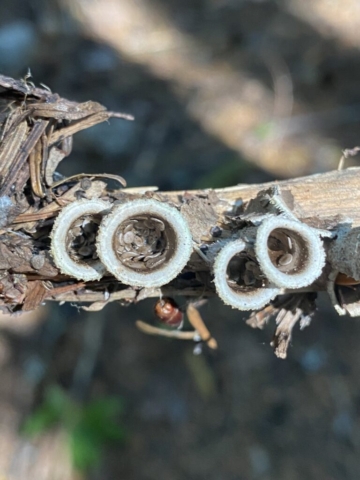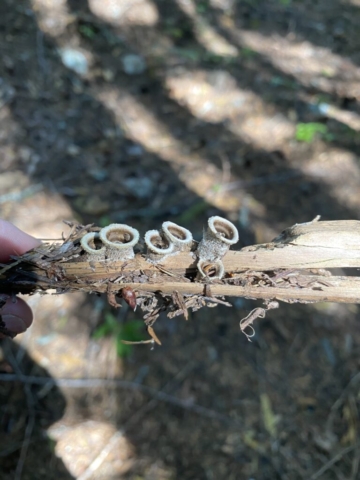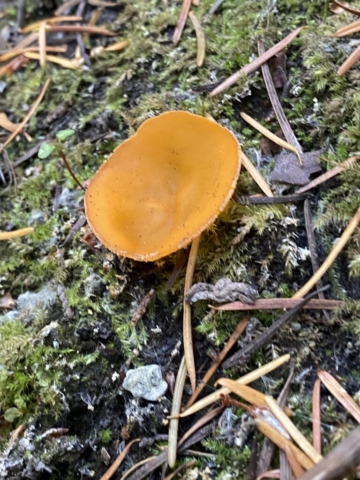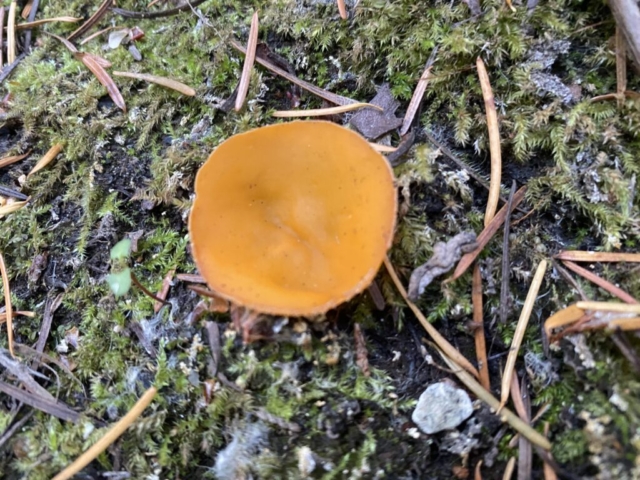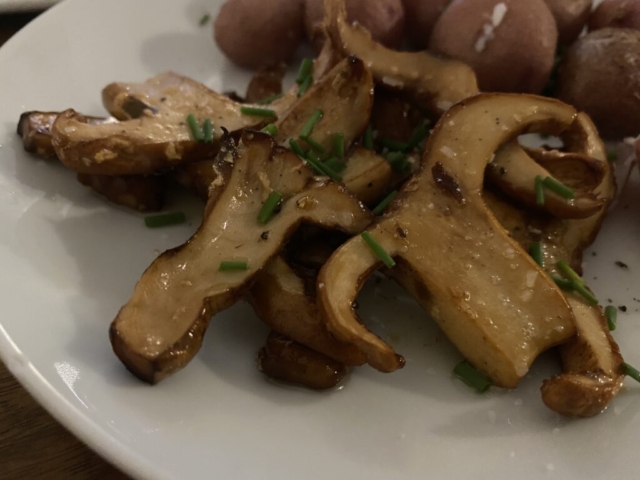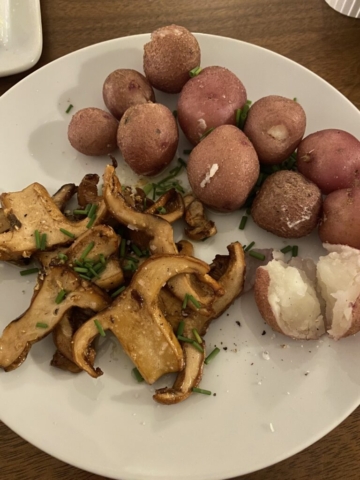Signed up for another mushroom identification and education course with Swallowtail Adventures.
Whistler is a mushroom hunters wonderland in October! Join Chef Robin for a mushroom tasting and cooking talk followed by a mushroom foray with the wonderful mycologist Willoughby Arevalo. We’ll meet at the beautiful Tyrol Lodge in Whistler, Chef Robin will fry up different kinds of wild mushrooms for you to try and then we’ll head out for a walk to identify edible wild mushrooms. On this trip we’ll learn about how to find and ID expensive matsutake (Pine mushrooms) that can be found in the area and many more.
Mycologist Willoughby Arevalo and Chef Robin Kort were our co-educators on our learning adventure on this warm and hazy (from the forest fires and autumn drought) morning in Whistler.
Mushrooms on Display
They had a lovely display available of different mushrooms for us to see before and after the course.
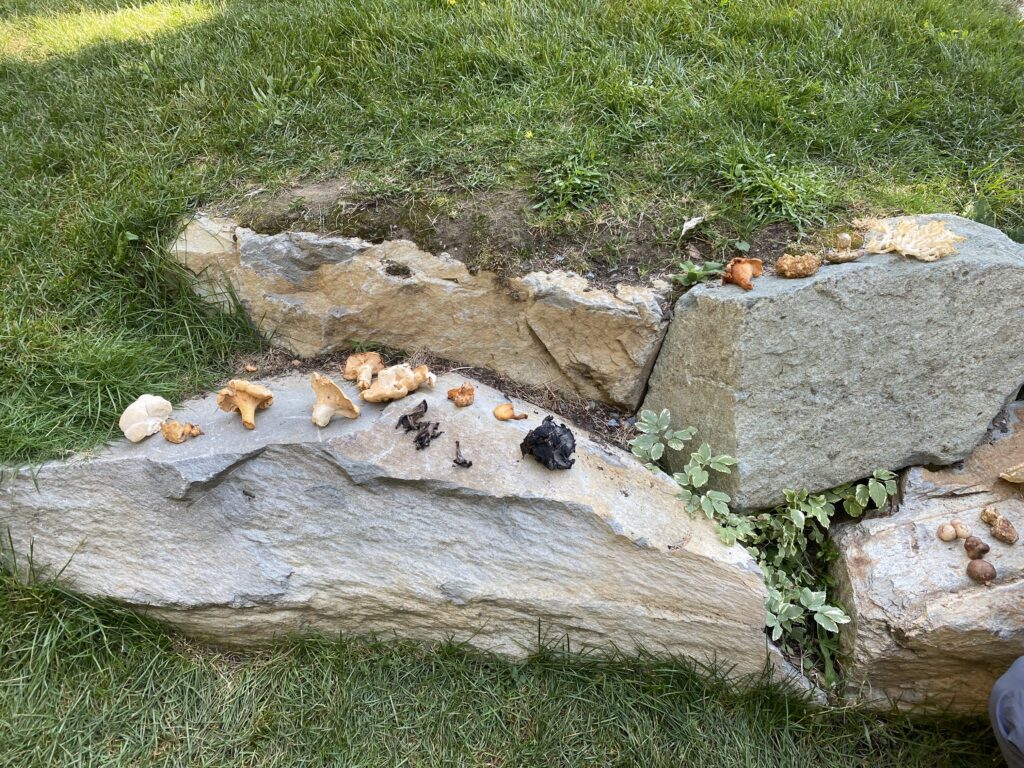
Lion’s Mane Mushroom (Hericium erinaceus) also called mountain-priest mushroom or bearded tooth fungus
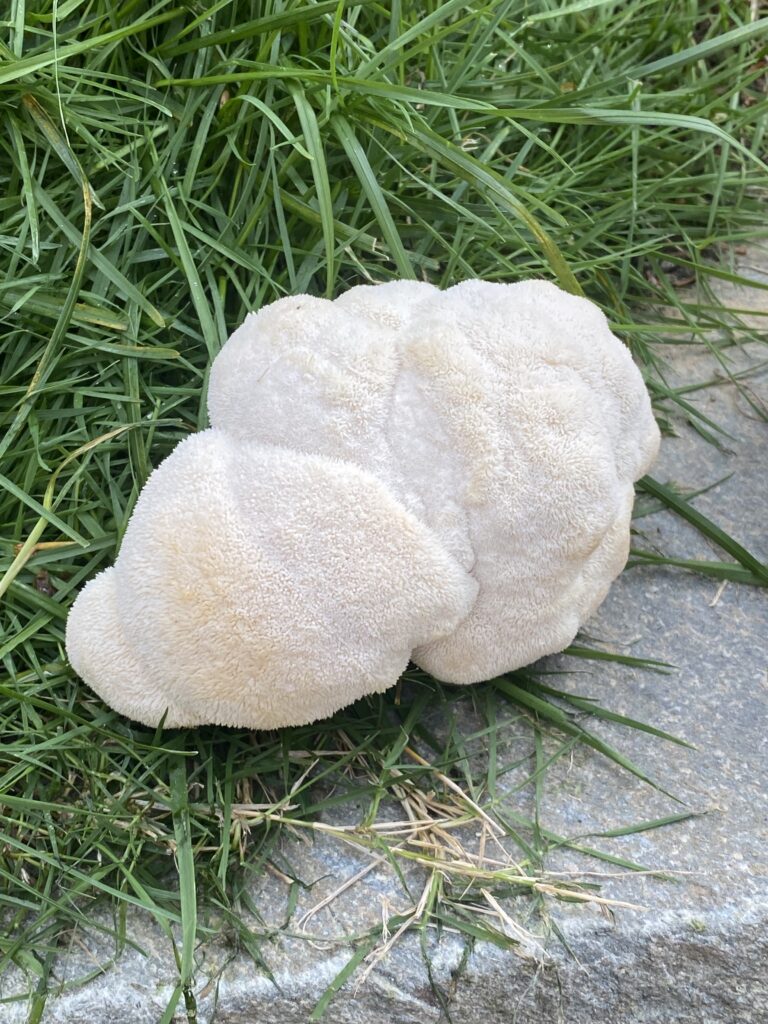
Hedgehog Mushroom (Hydnum repandum) commonly known as the sweet tooth or wood hedgehog
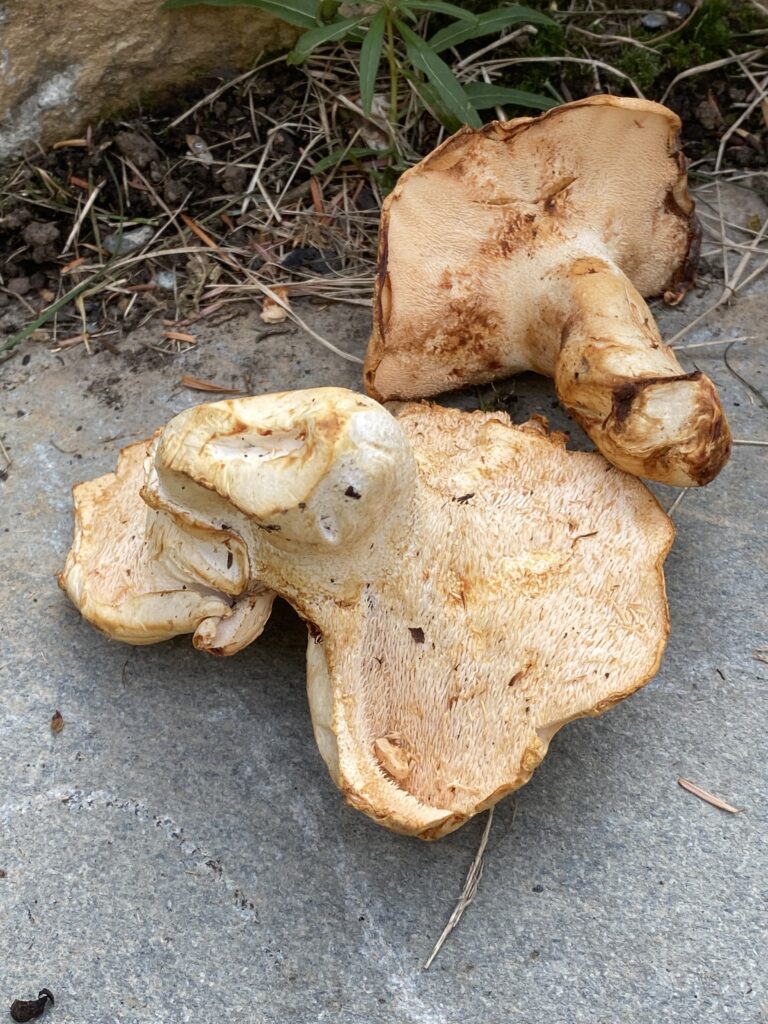
Chanterelle Mushrooms (Cantharellus)
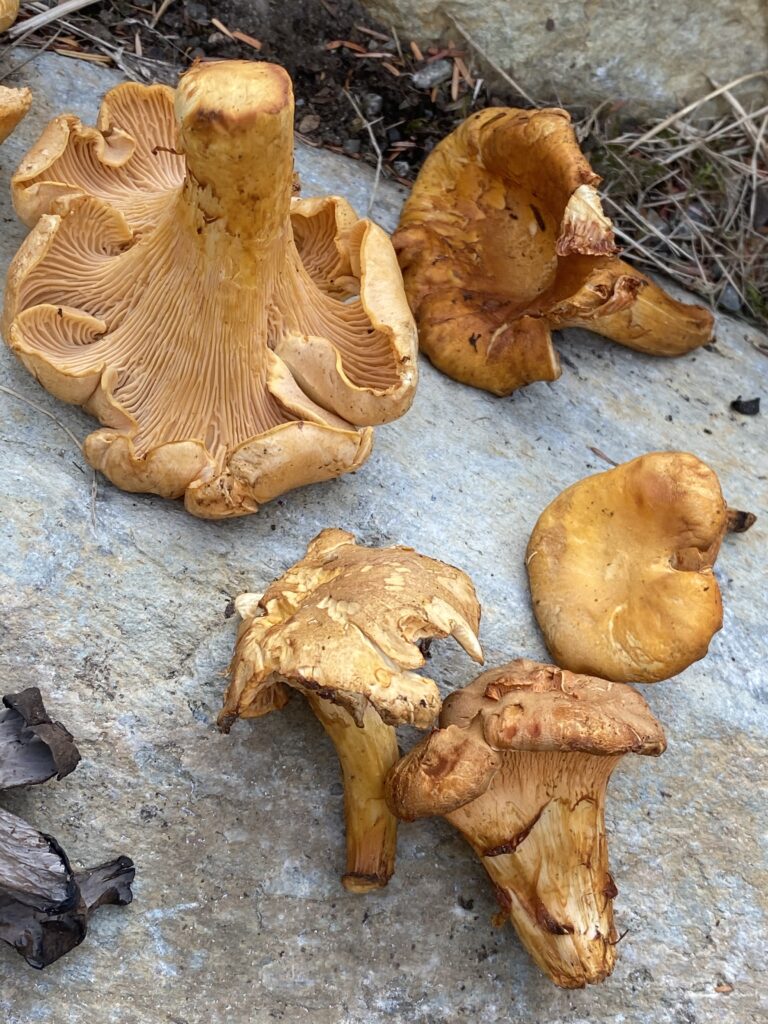
Black Trumpet Mushroom (Craterellus cornucopioides) also called horn of plenty, black chanterelle, black trumpet
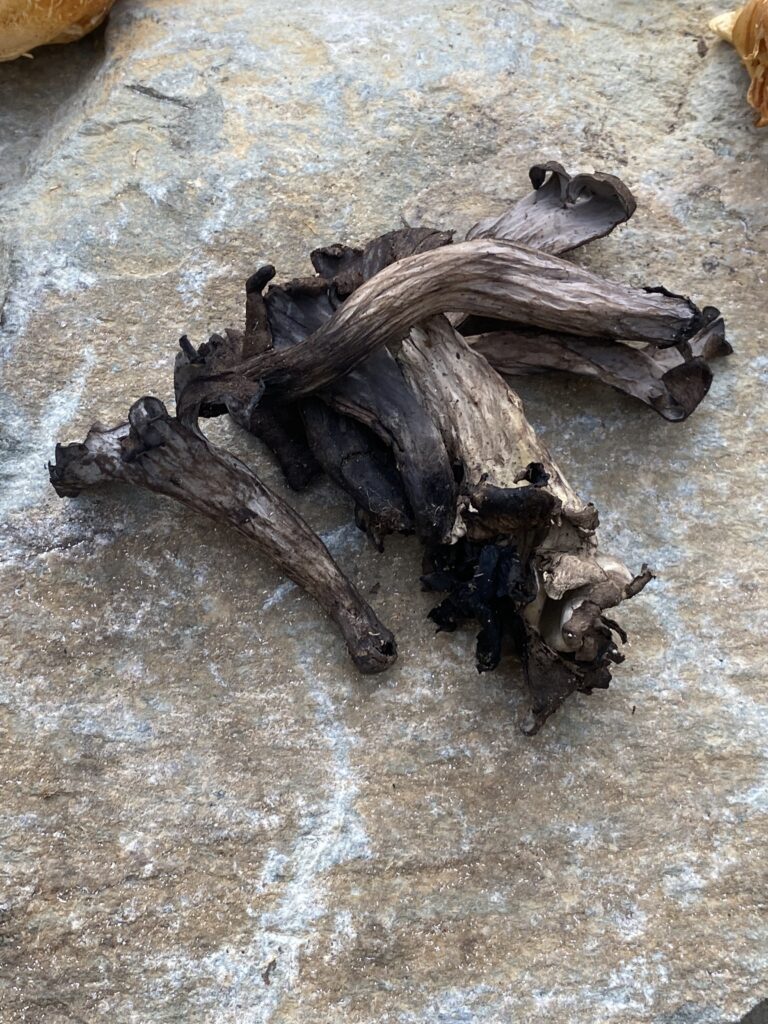
Blue Chanterelle Mushroom (Polyozellus multiplex)
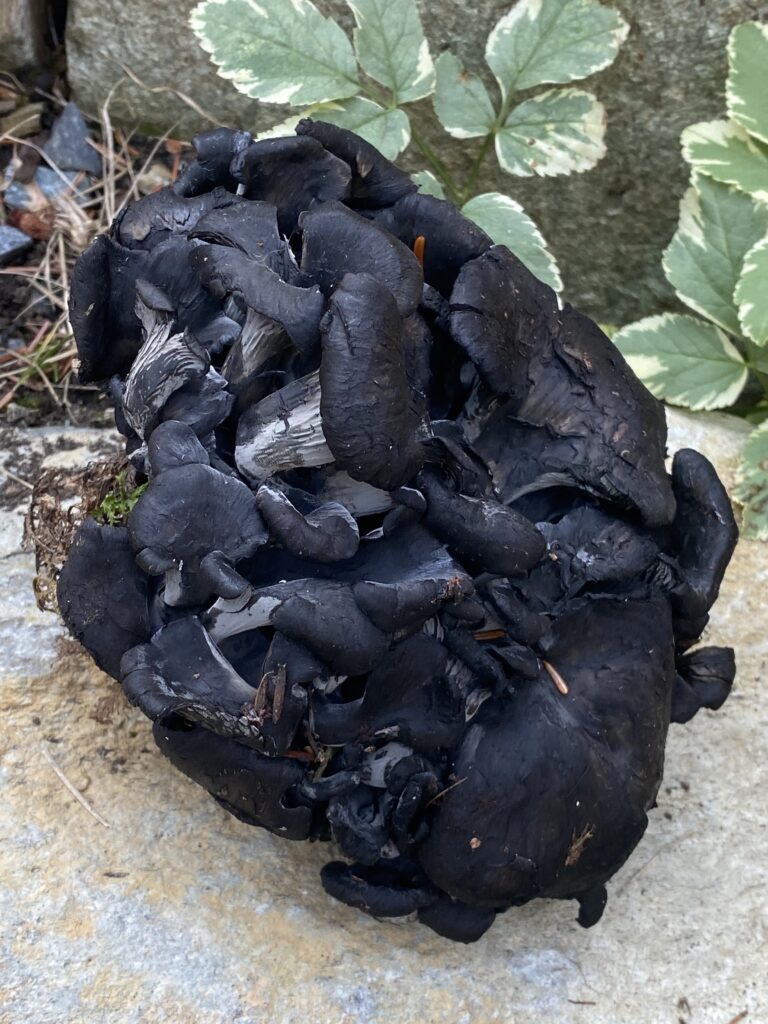
Comb’s Tooth Fungus (Hericium coralloides) also known as coral tooth fungus
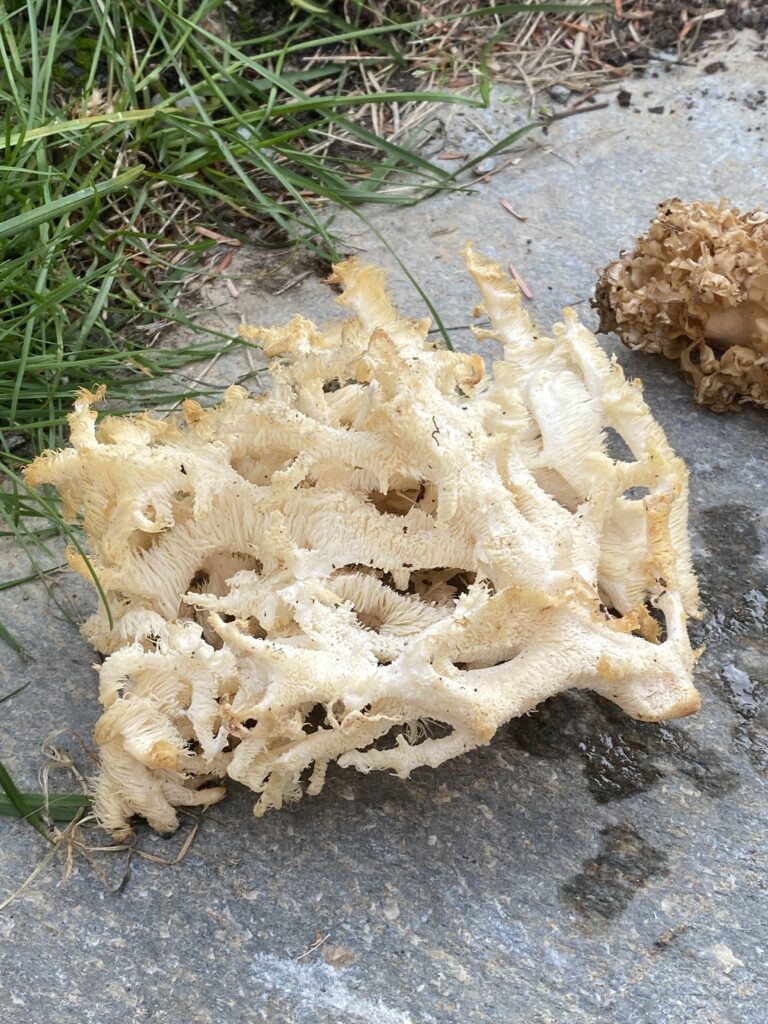
Cauliflower Fungus (Sparassis crispa)
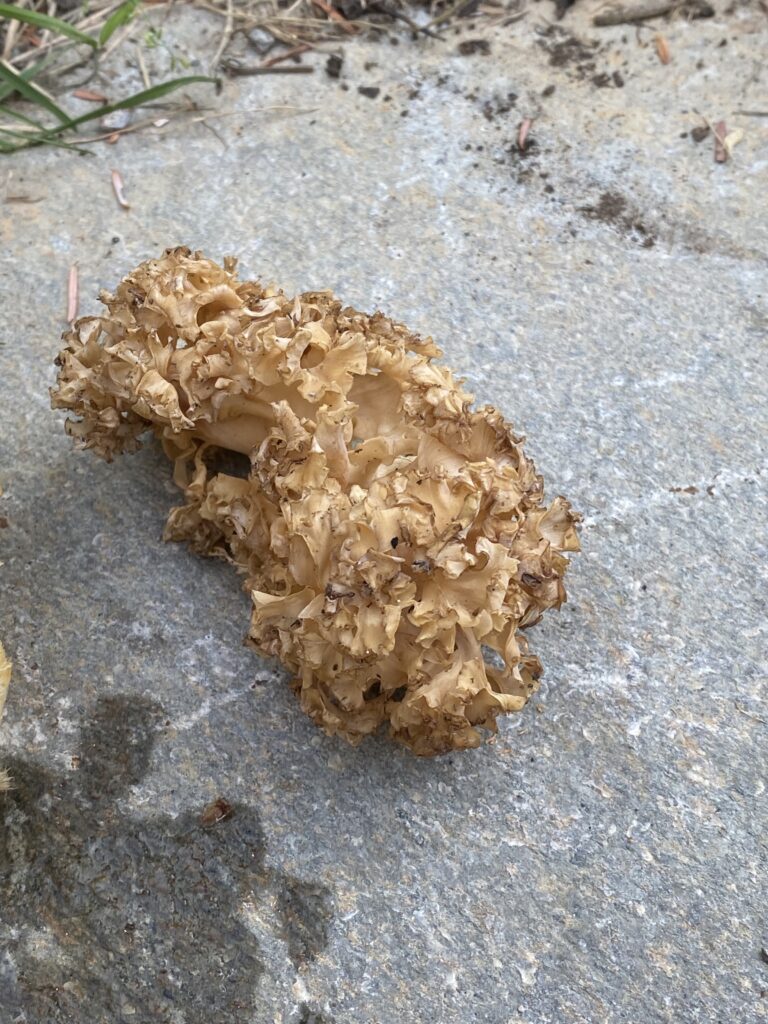
Matsutake (Tricholoma matsutake) also known as pine tree mushroom
Shiitake (Lentinula edodes)
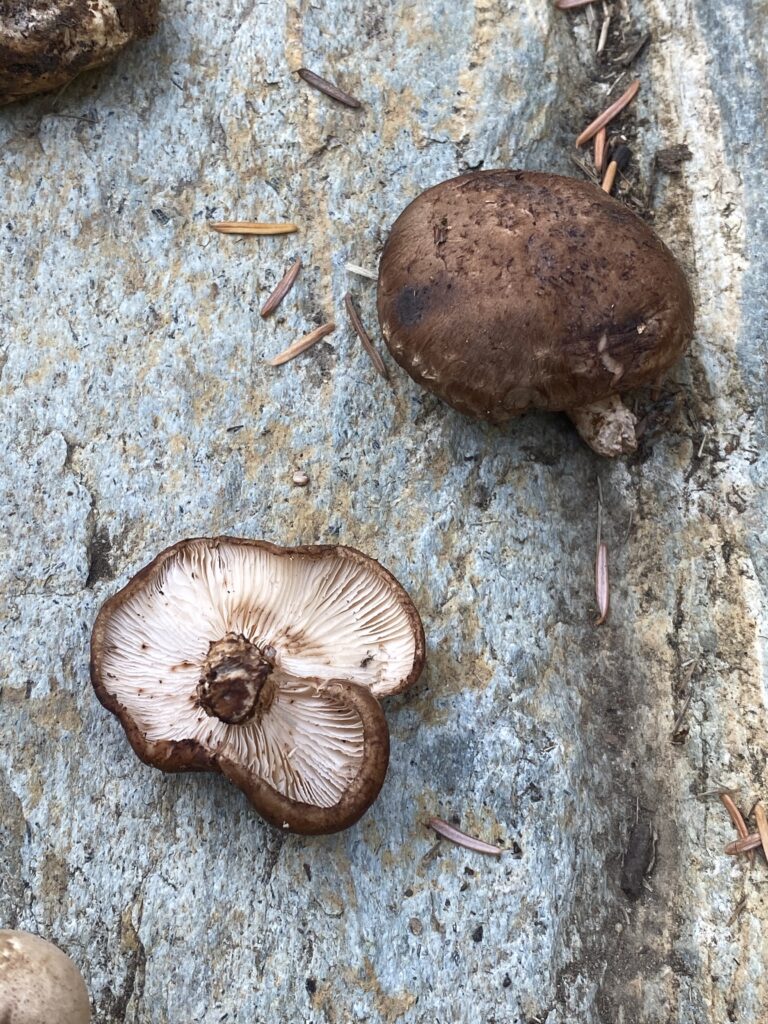
Puffball Mushroom (Genus: Calvatia, Bovista, and others)
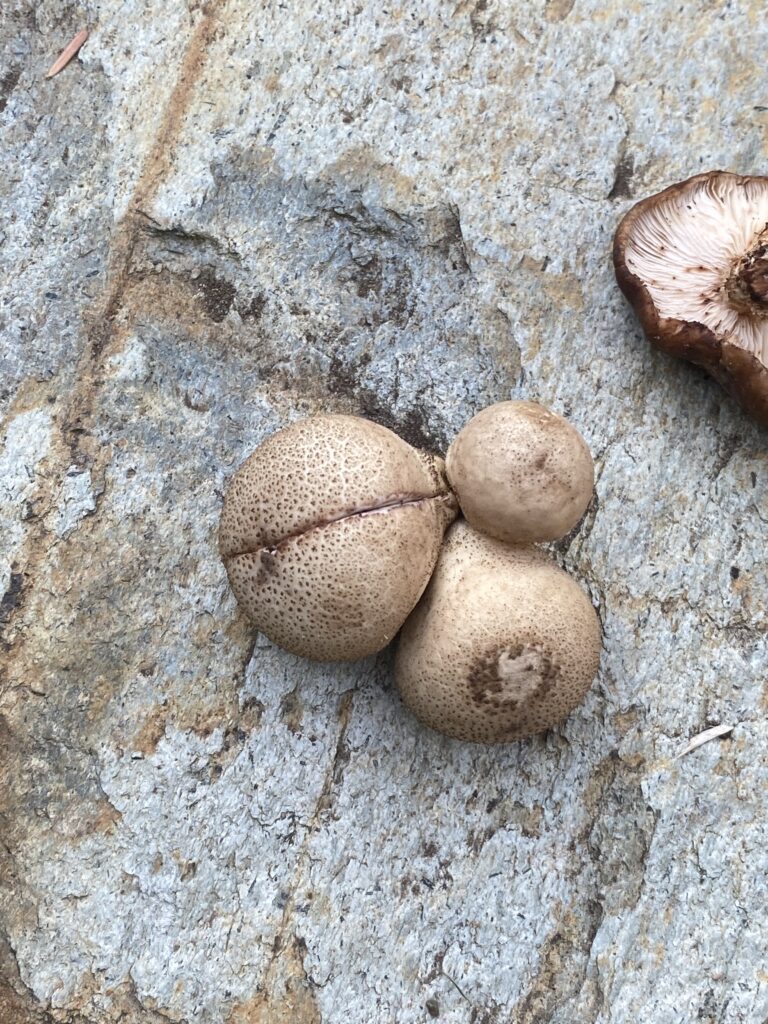
Amanita
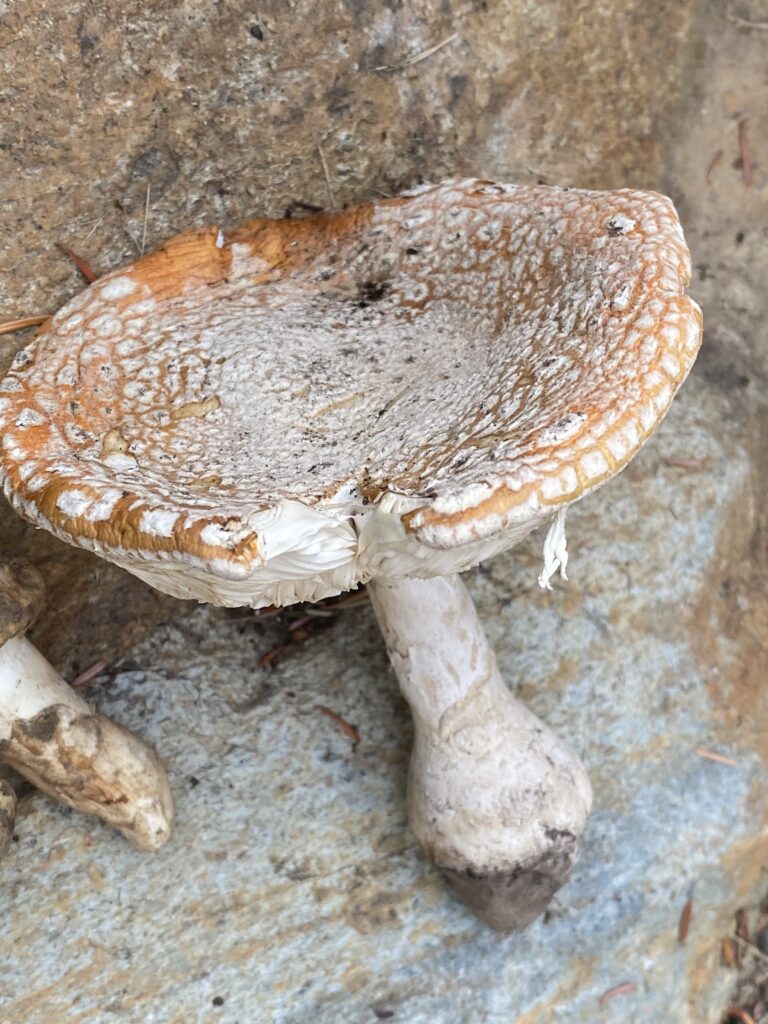
Introduction
- Mycelium are the ongoing body, mushrooms are the reproductive organs
- Can live from months to millennia
- There are some in the world that are 8000 years old
- Network interconnected web of microscopic tubelike cells through which nutrients, water, info, communications, etc is constantly flowing multi-directionally
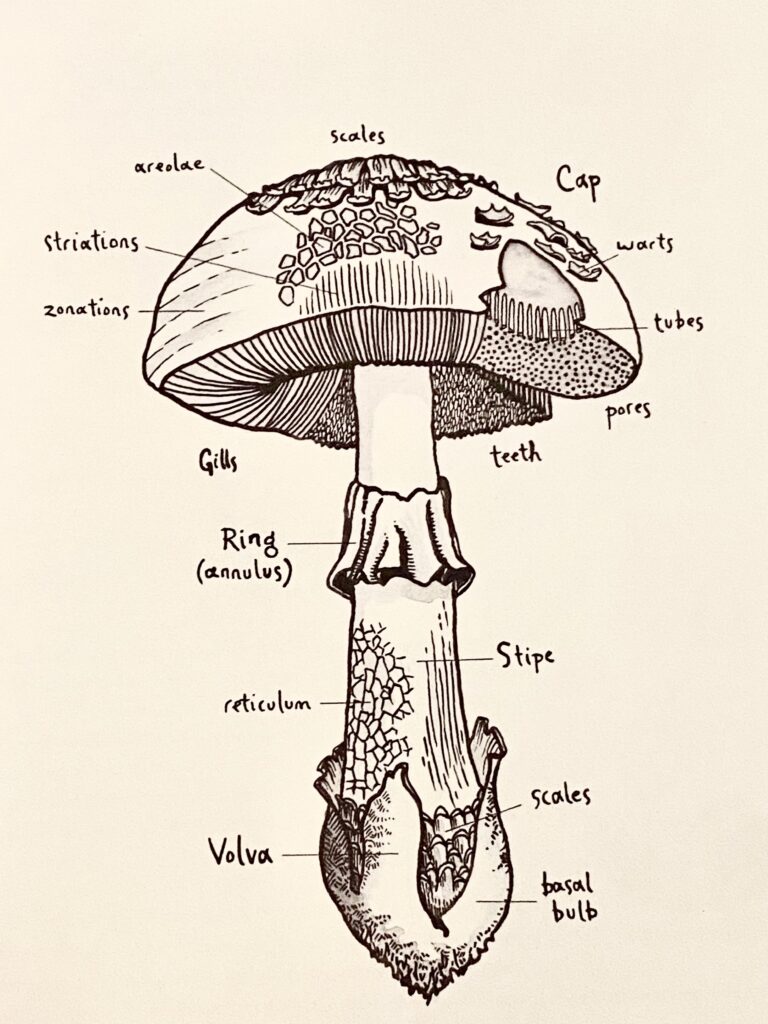
Arevalo, W. (2019, July 16). DIY Mushroom Cultivation: Growing Mushrooms at Home for Food, Medicine, and Soil (Homegrown City Life, 6). New Society Publishers, page 7
Identification
- Little brown mushrooms harder to identify, especially from photos
- Gilled mushrooms are the most common, so are harder to distinguish, whereas ones with teeth or pores
- Spore bearing surfaces under a cap such as gills, teeth or pores/tubes (spongy), wrinkly/vein
- Generally capped mushrooms starts out small with cap closed. As it fills with water & nutrients it expands
- Stalks can have silky, netted, scary, shaggy surface textures
- Veils – Often disappear with age. Universal veil which leaves vulva later
- E.g. amanita: red and white “fairytale” looking mushroom
- Matsutake- partial veil covers gills when young. More like a collar.
- Ring may be like a skirt, collar, powdery, granular, slimy, con-webby
- Shape, texture, color can be variable during parts of the life cycle
- Texture e.g. Chanterelle – tear is apart and it’s fibrous like string cheese.
- Certain ones will bounce back or others will crumble. Is it spongy? Stringy? ID also relies on pulling it apart, feeling it and using texture to distinguish
- Lookalikes – start with mushrooms that don’t have poisonous lookalikes. Start with edible mushrooms that are distinct
Safety
- Falls/getting lost most common safety hazard
- Don’t be too bold.
- Don’t get lost- read land and nature’s signs
- Tell someone where you’re going and when you’re coming back to checkin
- Wear good footwear and layers
- Essentials for going into wilderness:
- Flashlight
- Food
- Water
- Whistle
- Layers
- Good shoes
Harvesting
- Not harming the mycelium when you pick mushroom (like picking an apple)
- A lot of animals rely on mushrooms so be aware of how much you take and what you leave behind
- Use paper bags, never plastic
- As you harvest or move things, keep area pristine by covering and replacing areas turned over
- Protects environment where things are growing
- When you find a mushroom and have ID’d, leave one in fridge for poison control. Sorting through stomach contents is too difficult, so it’s a smart thing to do
- Asking for permission, thanking, acknowledging of the sacrifice and gift
- Learn to listen for an answer when you ask for permission
- Getting to know the mushrooms on the level of what their habits are, how abundant they are locally and in a broader sense
- Don’t harvest near contaminated grounds, polluted sites, mines, pesticide area
- Mycelium networks move minerals around really effectively so could gather pollution from one area and bring it elsewhere.
- Where to harvest – use BC forestry site and biogeoclimactic zones to find out which areas have certain trees. Look for creek lines or valleys, where there is more moisture.
Spore Prints
- To make spore print (how to learn spore color of mushroom)
- Remove stem
- Place on paper, cover with bowl
- Leave undisturbed
- Should see deposit of spores
- Works best with mature and moist
- Crucial ID feature, ESPECIALLY gilled mushroom
Scavenger Hunt
First Chef Robin Kort had us do a scavenger hunt for five mushrooms. Full disclosure: she had placed all these mushrooms throughout the patch of forest as part of the activity. The point was to learn how to spot these five edible mushrooms in their natural environments – where we’re most likely to find them – and train our eyes to spot these mushrooms when in the wild.
Chicken of the Woods
Laetiporus sulphureus, also more commonly known as Sulphur Shelf, Mushroom Chicken, and Rooster Comb
- Saprophytic mushroom (Saprophytic fungi feed on dead plant and animal remains)
- Found on dead wood
- Can be found on conifer wood
- In urban places can be found on hardwood like ornamental cherry trees
- Yellow pores
- No gills, no teeth
- Orange top (color can change, such as more beige)
- Never each mushroom close to stem – it’s woody and bitter. Cut the outer rim where the texture that is softer
- Cook it really well!
- No inedible lookalikes
Cauliflower Fungus
Sparassis crispa
- Parasitic on Douglas fir roots
- Often close to base of Douglas fir
- White/creamy cauliflower-like objects at base
- Smells like fruity aroma
- Almost like a noodle when cooked because they remain firmer
Comb Tooth Fungus
Hericium coralloides, also called Bear’s Head
- Grows on dead wood
- Conifer and hardwood loving
- Likes cottonwoods
- Good fried
- Great for beginners
- Nothing looks like this
- Teeth grow down from each of the stems
- Fruity aroma
Pine Mushroom
Tricholoma murrillianum, closely related to Matsutake (Japanese Pine Mushroom – Tricholoma matsutake)
- Mycorrhizal symbiotic
- Grows in a line along the root
- Little divots and pockets of moisture
- Mossy areas and sometimes underneath the moss
- On the coast – matsutake it has a poisonous lookalike!
- Can look almost the same!
- Differentiate- texture – hard
- Cinnamon and red hots smell
- Lookalike is Amanita smithiana – deadly poisonous!!!! Beware as this is common in coastal regions
- No Amanita smithiana in the interior (Okanagan) poisonous lookalike so easier to distinguish there
- Tip of the stem- grey soil. Distinctive to the matsutake. Needs it to grow. Identifying feature
Golden Chanterelle
Cantharellus cibarius
- Similar to pine mushrooms. Likes pockets and divots near fallen logs
- Where moisture collects
- If a Douglas fit is near, chanterelle often around
- If you find one, then can triangulate your find them in the areas where the roots are
Importance of Trees
Many mushrooms have important relationships with trees, so understanding where to find mushrooms also means understanding and learning about the trees with which certain mushrooms are usually found.
Douglas Fir
- Most important tree in PNW
- Symbiotic Mycorrhiza
- Bark is thick like a scab
- Withstanding forest fire
- Douglas fir cones have two back legs of a mouse and a tail
Spruce
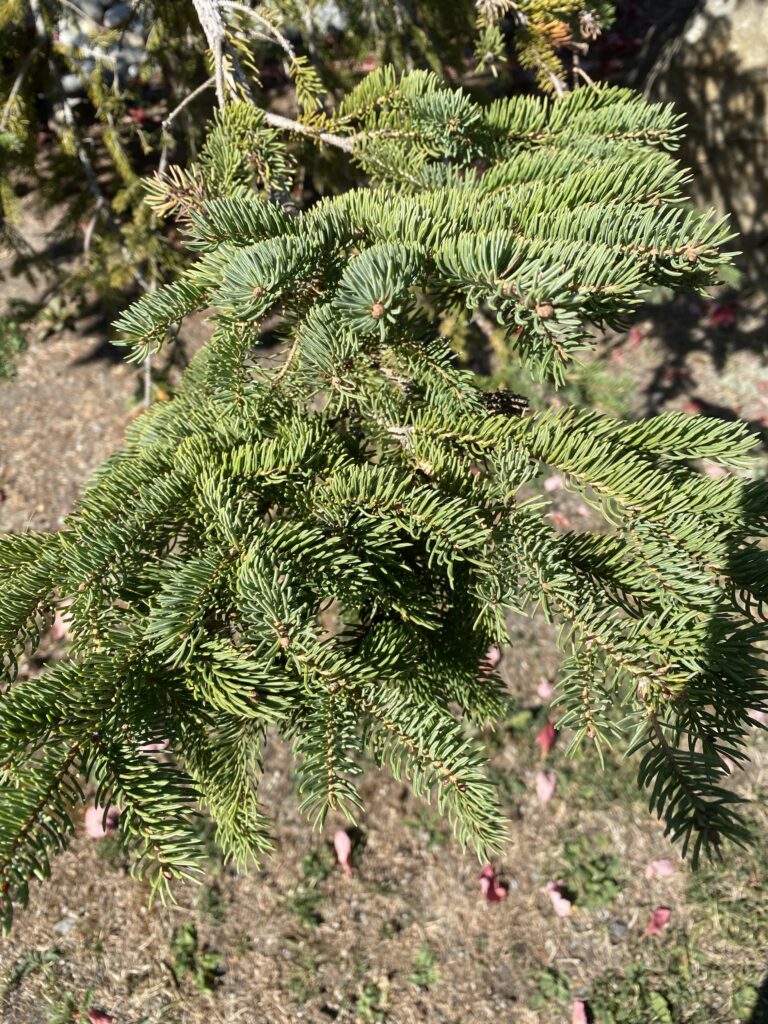
- Needles very sharp – very prickly and spiky
- Bluish coloration
- Near spruce,
- Hedgehogs, blue chanterelles, porcini
Cedar
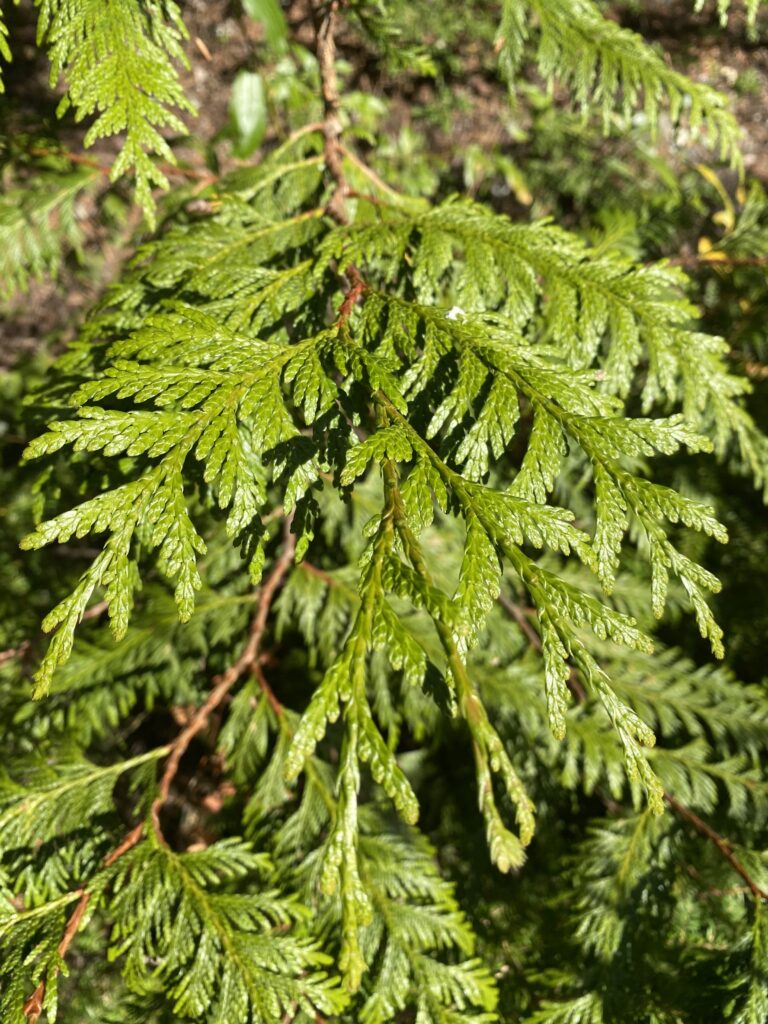
- Needles of cedar are scale like formation bark is distinction
- Most edible mushrooms don’t grow around cedar
- Cedar like acidic soils so most mushrooms don’t hang around cedar
Western Hemlock
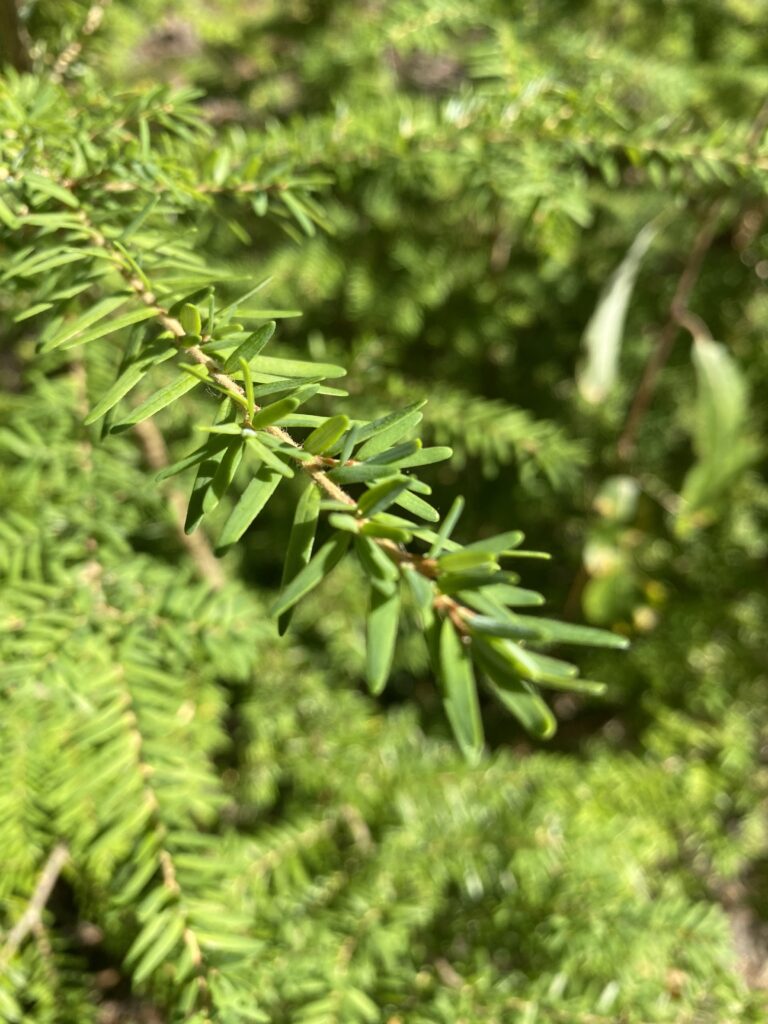
- Porcini, hedgehogs and many other mushrooms
- Needles are all different lengths (whereas spruce and Douglas fit are usually consistent needle length)
- Tiny cones
Alder
- A medium-sized broad-leaf tree, up to 24 metres tall.
- White to cream colored trees
- Wild oyster often found on them
Identifying Wild Mushrooms
The next part of the education class was going into the forest and mycologist Willoughby Arevalo who showed us mushrooms that were growing in the wild. Many of these mushrooms were not edible, but it was an interesting learning on different types of mushrooms and what species can be found in the Pacific Northwest forests.
Veiled Oyster Mushroom
Pleurotus dryinus
- Not really clustered like other oysters
- Scaly cap- a bit of veil that covers gills that disappear
- Not as tender or tasty as other oysters
- Alder is best tree to look for oyster
- Oyster shape shell
Turkey Tail Mushroom
Trametes versicolor
- Polypore (group of fungi that form large fruiting bodies with pores or tubes on the underside)
- Polypore or shelfing mushrooms often used medicinally such as tea.
- Not in culinary realm
- Well known for medicinal properties
- Concentric zones different colors
- No poisonous lookalikes.
- Cap has velvet zones of different colors in top
- Bottom whiter in color
Green Elf Cup
Chlorociboria aeruginascens, also commonly called green wood cup or green stain fungus
- Wood that is prized by woodworkers for inlay in fine woodworking
- Pigments that mycelium produces as it consumes the tree
- Mushrooms themselves fairly unremarkable
Conk
Ganoderma applanatum, also called artist’s bracket, artist’s conk, artist’s fungus or bear bread
- Woody polypore
- Pictures are of young conk and older conk
- Can tap with finger and it goes “conk”
- Important because it turns dead trees into soil
- Important in human history- acted as a means to carry fire for survival
- Not great for palettes- rubbery taste
Alcohol Inky Caps
Coprinopsis atramentaria, commonly called ink cap, inky cap, tippler’s bane
- Shaggy manes (better known relative)
- Type of inky cap
- Mushrooms the digest their own gills to make space to release spores
- Giant dusting of black spores
- Edible mushroom IF you don’t drink alcohol
- Contains toxin that interacts with alcohol inside body to inhibit metabolism of alcohol leading to alcohol poisoning
Puffballs
Lycoperdon perlatum
- Decomposed mushroom
- Start out pear or ball shaped
- Thin outer membrane and interior that begins white
- As they mature, they make spores inside then it becomes powdery and dry
- And when drops on them or when disturbed by animals, spores go poof!
- Accumulate heavy metals, so beware where you harvest
- Beginner friendly – easy to recognize
- Slice vertically to make sure they’re not amanitas at a baby stage
West Coast Reishi
Ganoderma oregonense
- Medicinal
- Shiny lacquered upper
- Commonly found on dead hemlock, especially stumps
Honey Mushrooms
Armillaria
- Highly variable in color
- Clustered
- Honey mushroom comes from color in caps (not taste)
- Cap can be dry or slippery
- Can become flat or wavy
- Base of stalk on outside usually yellowish to olive green
- Always poisonous raw
- Don’t eat when overly mature can cause digestive upset
- Because of its high variation in looks, not a beginner mushroom
- One of these species in Oregon is the oldest and largest known mycelium
Cortinarius
- (Meaning having a curtain)
- Genus that live in mutual symbiosis with trees
- Swapping minerals and water with trees in return for photosynthetic sugars
- Veil is cob-webby
- Highly variable
- Most are not known to be edible
Enteloma
- Spongy ground
- Wood chip piles are a good area for certain mushrooms
- Very few edible
- Some significantly poisonous
Birds Nest
Nidulariaceae
Orange Peel Fungus
Aleuria aurantia
Not wild… but today we learned: Flowerpot Mushroom
Leucocoprinus birnbaumii, common names of flowerpot parasol and plantpot dapperling
Lepiota lutea (= Leucocoprinus luteus)
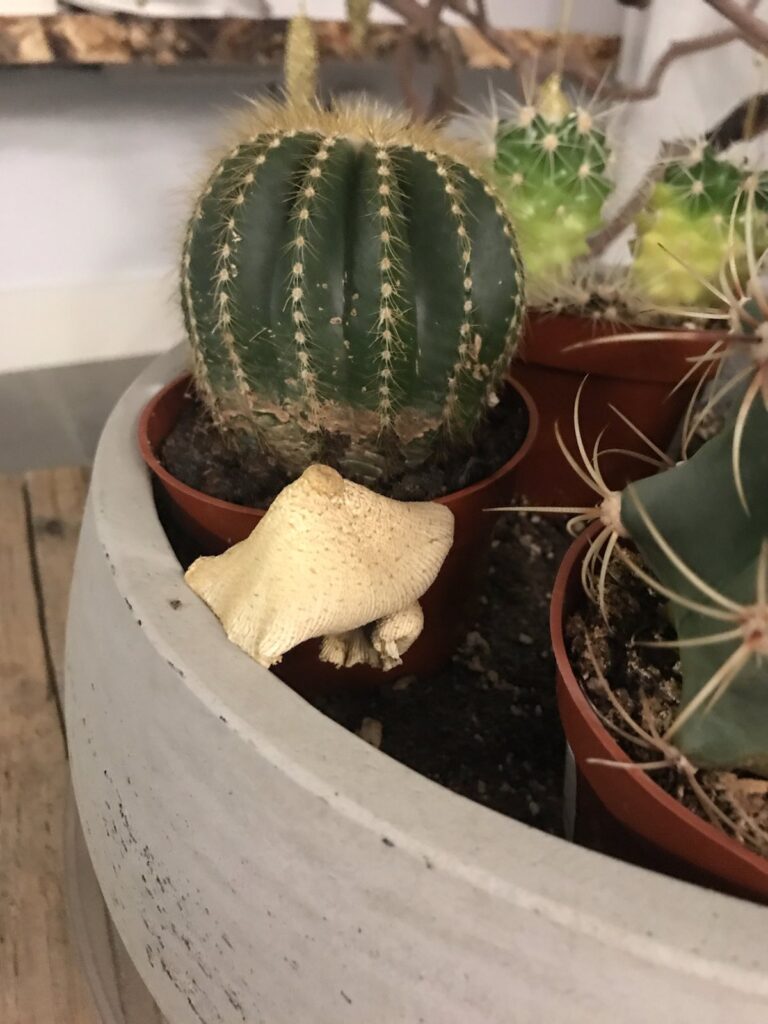
- Dad brought a mushroom which has been growing with his indoor cacti and asked Willoughby to identify it. Turns out it is so common in house plant soil it is called “flowerpot mushroom”.
- Not edible
- Pretty sure S and I have had a ton of these pop up in different house plant pots over the years. Interesting to know!
Mushroom Tasting
To end the day of learning, Chef Robin made a delicious mushroom soup for the tasting portion of our mushroom class. This was experiencing the smell, flavours and textures of some of the edible types of mushroom . It was four types of mushrooms in a delicious dashi broth. YUM!
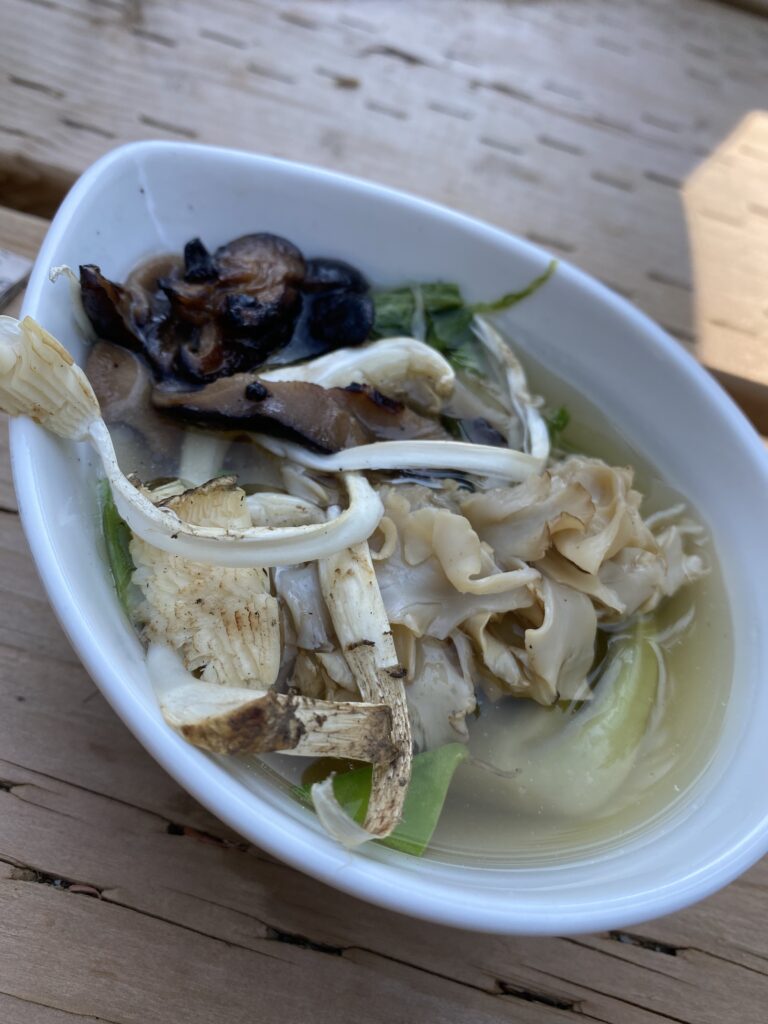
Cauliflower mushroom
Lions mane
Pine Mushroom / Matsutake
Shiitake
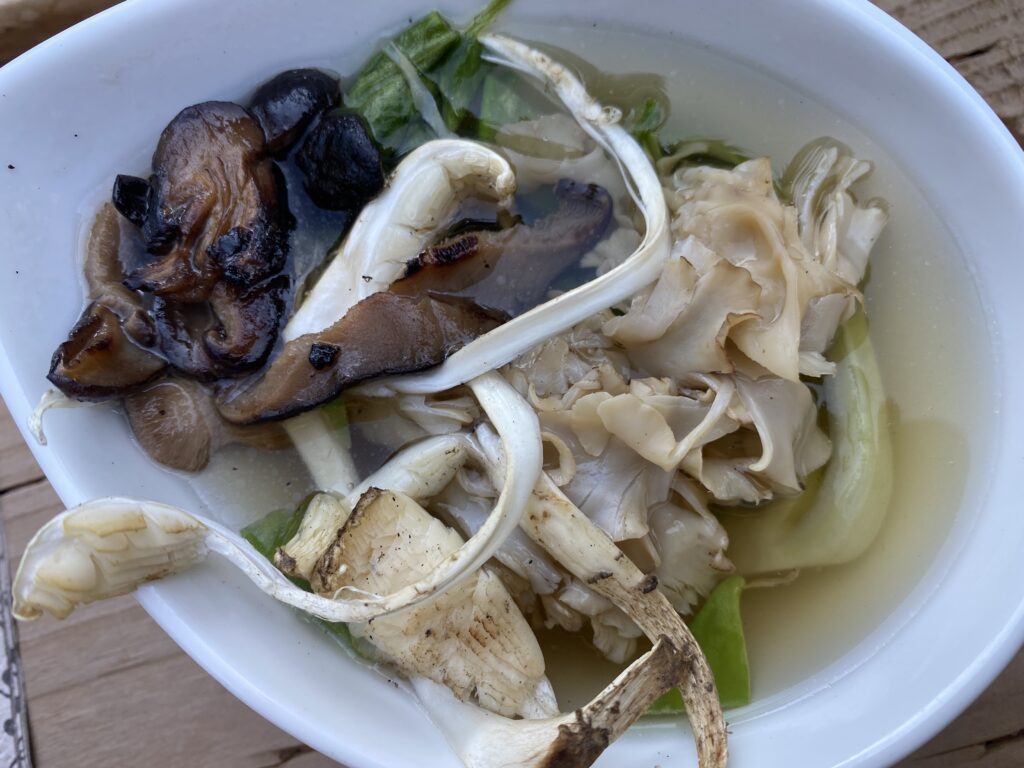
Mushrooms for Dinner
Chef Robin shared the display mushrooms with participants as we left. Dad, S & I then got chanterelle and hedgehog mushrooms between the two of us. S sautéed them up for dinner and we had them with roasted potatoes from our garden. A simple but delicious meal!
That’s all for now…
Appreciative to Chef Robin & Willoughby and the learning and wisdom they shared with us all over the class. Gratitude for the lands which nourish us and sustain us. This class took place in Whistler, which is the stolen land of the Lil’wat Nation and Squamish Nation. As I continue to explore the natural world, I am grateful for these experiences and hope that my own learning will have ripple effects on how I show up in the world and the impacts of the place and community around me.
